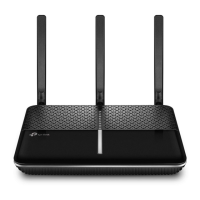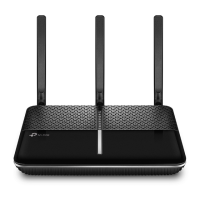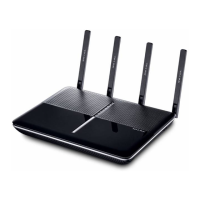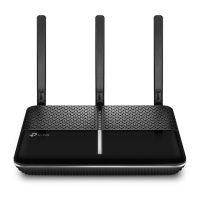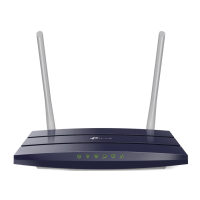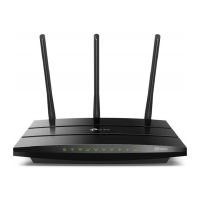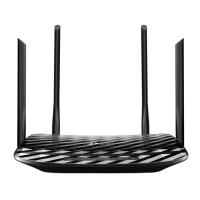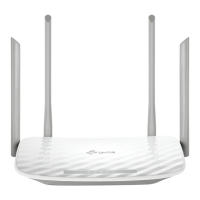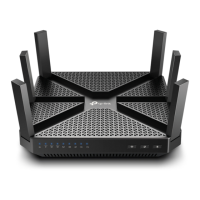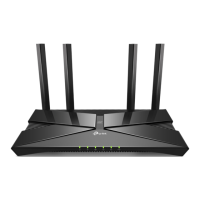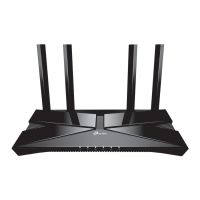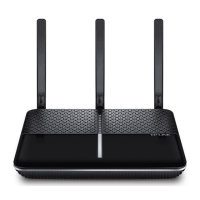
Do you have a question about the TP-Link Archer VR900 and is the answer not in the manual?
| VPN support | PPTP, L2TP, IPSec Passthrough |
|---|---|
| Ethernet LAN | Yes |
| Cabling technology | 10/100/1000Base-T(X) |
| Networking standards | IEEE 802.11a, IEEE 802.11ac, IEEE 802.11b, IEEE 802.11g, IEEE 802.11n, IEEE 802.3, IEEE 802.3ab, IEEE 802.3u |
| VPN tunnels quantity | 10 |
| Ethernet LAN data rates | 10, 100, 1000 Mbit/s |
| Ethernet LAN interface type | Gigabit Ethernet |
| Wi-Fi band | Dual-band (2.4 GHz / 5 GHz) |
| Wi-Fi standards | 802.11a, Wi-Fi 5 (802.11ac), 802.11b, 802.11g, Wi-Fi 4 (802.11n) |
| Top Wi-Fi standard | Wi-Fi 5 (802.11ac) |
| WLAN data transfer rate (max) | 1300 Mbit/s |
| WLAN data transfer rate (second band) | 600 Mbit/s |
| Input current | 3.3 A |
| Input voltage | 12 V |
| Rack mounting | No |
| Frequency band | 2.4 & 5 GHz |
| Minimum system requirements | Internet Explorer 11, Firefox 12.0, Chrome 20.0, Safari 4.0\\r Cable / DSL Modem |
| WLAN data transfer rates supported | 600, 1300 Mbit/s |
| RJ-11 ports quantity | 1 |
| Ethernet LAN (RJ-45) ports | 4 |
| USB 3.2 Gen 1 (3.1 Gen 1) Type-A ports quantity | 2 |
| Data link protocols | IPv4, IPv6 |
| Supported network protocols | ATM Forum UNI3.1/4.0, PPP over ATM (RFC 2364), PPP over Ethernet (RFC2516), IPoA (RFC1577/2225), MER\\IPoE (RFC 1483 Routed), Bridge (RFC1483 Bridge), PVC |
| Transmit power | 0 dBmW |
| Antennas quantity | 3 |
| Antenna connector type | RP-SMA |
| Antenna gain level (max) | 3 dBi |
| Security algorithms | 128-bit WEP, 64-bit WEP, WPA, WPA-PSK, WPA2, WPA2-PSK |
| Product type | Tabletop router |
| Product color | White |
| Mac operating systems supported | macOS |
| Windows operating systems supported | Windows 2000, Windows 2000 Professional, Windows 7 Home Premium, Windows 7 Home Premium x64, Windows 7 Professional, Windows 7 Professional x64, Windows 7 Starter, Windows 7 Starter x64, Windows 7 Ultimate, Windows 7 Ultimate x64, Windows 8, Windows 8 Enterprise, Windows 8 Enterprise x64, Windows 8 Pro, Windows 8 Pro x64, Windows 8 x64, Windows 8.1, Windows 8.1 Enterprise, Windows 8.1 Enterprise x64, Windows 8.1 Pro, Windows 8.1 Pro x64, Windows 8.1 x64, Windows 98SE, Windows NT, Windows Vista Business, Windows Vista Business x64, Windows Vista Enterprise, Windows Vista Enterprise x64, Windows Vista Home Basic, Windows Vista Home Basic x64, Windows Vista Home Premium, Windows Vista Home Premium x64, Windows Vista Ultimate, Windows Vista Ultimate x64, Windows XP Home, Windows XP Home x64, Windows XP Professional, Windows XP Professional x64 |
| Output current | 2.5 A |
| Power source type | AC |
| Storage temperature (T-T) | -40 - 70 °C |
| Operating temperature (T-T) | 0 - 40 °C |
| Storage relative humidity (H-H) | 5 - 90 % |
| Operating relative humidity (H-H) | 10 - 90 % |
| Certification | CE, RCM, RoHS |
| Cables included | DSL, LAN (RJ-45), Phone (RJ-11) |
| WAN connection type | RJ-45 |
| 3G | - |
| Package depth | 240 mm |
| Package width | 318 mm |
| Package height | 71 mm |
| Package weight | 1270 g |
| Harmonized System (HS) code | 85176990 |
| Depth | 163.7 mm |
|---|---|
| Width | 215.7 mm |
| Height | 38.9 mm |
| Weight | - g |
Details the modem router's features and capabilities.
Lists the key functionalities and specifications of the modem router.
Instructions on how to access and log into the modem router's web interface.
Guide to setting up internet connections using the wizard.
Steps for manual internet connection configuration without the wizard.
Instructions on how to manage and control network bandwidth for devices.
How to use MAC filtering to control network access for devices.
Setting up access control (Blacklist/Whitelist) for wired and wireless devices.
Binding IP and MAC addresses to prevent ARP spoofing and attacks.
Sharing USB storage devices with network clients.
Instructions on downloading and installing the latest firmware for the modem router.
Backing up and restoring router settings, and resetting to factory defaults.
Steps to restore the modem router to its factory default configuration.
Procedures for recovering or resetting lost web management and wireless passwords.
Troubleshooting steps for accessing the modem router's web interface.
Steps to diagnose and resolve issues preventing internet access.
Steps to resolve issues finding or connecting to the wireless network.
